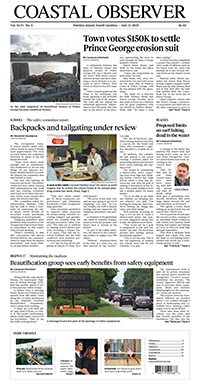Beaches
Sand will run out before the money does, hazards expert says

Rob Young thought he could improve on the WNC Strong slogan created after flooding from Hurricane Helene wreaked havoc in the mountains of western North Carolina.
How about WNC Smart? It hasn’t caught on. And Young, a geology professor and director of the Program for the Study of Developed Shorelines at Western Carolina University, is not surprised. Data that he has collected about beach nourishment projects since the 1980s shows why.
With just the amount of sand moved in Southern states in the last 25 years, Young said, “you could build a beach from the Virginia line all the way around to the Mississippi-Louisiana line that would be about 1,200 feet wide and would be about 10 feet thick. This is our current coastal management strategy.”
Young told the audience at the 15th annual Wild Side benefit for the S.C. Environmental Law Project that the strategy isn’t smart or sustainable.
He said he is often asked why a coastal hazards specialist lives in the mountains.
“Well, I know too much about hurricanes to live at the coast,” used to be his reply. “I’m going to have to rethink that.”
The area around Asheville, N.C., was often cited as a destination for people moving from storm risks in Florida.
“The lesson is, there are no climate havens in the United States of America right now,” Young said, choking up. “There are no climate havens.”
Beachfront management has always been a key issue for the law project, said Amy Armstrong, its executive director.
“The beachfront is really symbolic of the public interest in our state’s resources,” she said.
Under the “public trust doctrine,” the state of South Carolina owns all the land below the high water mark and holds it in trust for the citizens. That is a tool the law project uses in its work.
“Literal and figurative lines in the sand must be drawn, and they must be enforced so that land and life have a chance to adapt to rising sea levels, extreme weather and other climate impacts,” Armstrong said.
Young is worried that South Carolina may weaken its Beachfront Management Act. This year, Gov. Henry McMaster vetoed a budget proviso that would have allowed private property owners to keep seawalls that state regulators had declared illegal.
“I want to give the governor credit for that,” Young said.
After Hurricane Ian in 2022, Florida created a fund to pay private property owners to build seawalls. It was renewed this year.
“Here’s the nightmare scenario: We start building these seawalls, it’s not just about the beach disappearing and we have a taking of habitat for turtles and birds. Neighbors will start suing neighbors,” Young said.
The ends of the seawalls have greater impacts and the structures built by individual property owners won’t all be the same.
“I could make a living for the rest of my life in Florida with lawsuits of people suing each other over seawalls,” Young said.
Beach nourishment has also led to suits over sand sources and drawn opposition from shellfishing interests because of its impact on the environment, he said.
That’s why Young said the current coastal management policy doesn’t make sense.
“We’re trying to hold it all in place forever without any real discussion as to whether or not it’s possible, whether or not it’s sensible and what the environmental impacts are of doing so,” he said.
And Young added that much of the property that this strategy tries to protect – mostly with public money – is investment property, not primary homes.
“We are, in fact, privatizing most of the profits and socializing the risk,” he said. “Markets are not guiding decision making at the coast because most of the development that’s happening is relying on that public risk subsidy.”
He estimates that the U.S. has already spent $10 billion on beach nourishment, with other public funds going to flood insurance and disaster assistance.
“You know what we get back for that money? Nothing,” Young said.
He concedes that communities will argue that protecting private property protects tax revenue.
“What we don’t get back from all of that spending is resilience,” he said.
Only a few communities pay the full cost of placing sand on the beach. Young sees that as part of the problem.
“I always figure if you have more skin in the game you’ll care about the science and how long it can actually work,” he said. “The fact of the matter is that it’s not sustainable. We can’t hold it all in place forever. We just can’t. We’re going to run out of sand before we run out of money.”
The Army Corps of Engineers, which conducts beach nourishment projects, doesn’t assess it’s overall environment impact, he added. Dredging the sand offshore disrupts the ocean bottom and placing it on the beach kills creatures that live in the tidal zone. They will come back, but not if the work is done repeatedly, he said.
On the North Carolina coast, the intertidal zone at Cape Lookout has never been disturbed. “There are foraging shorebirds all over the place. If you go to Carolina Beach, N.C.,” he said, the site of ongoing renourishment, “the only foraging shorebird is a seagull with a french fry in his mouth.”
The environmental impacts have economic impacts, Young said. The S.C. Beachfront Management Act wasn’t about environmental protection, but economic protection.
“If the beaches go away, oceanfront property owners will still have a view, but mom and pop businesses in those communities will not have visitors. The beaches are the economic engines,” he said.
Young uses the law as a model in talks around the country. He hopes that the public will push back if lawmakers try to weaken it.
And he hopes there will be a wider conversation about where federal support is warranted and where it isn’t.
“We’re probably going to get tens of billions of dollars in federal aid in western North Carolina because of this storm,” Young said. “We should be required to build smarter.”




